H O M E • V
O R T E X 1 • V
O R T E X 2 • V
O R T E X 3 • V
O R T E X 4 • V
O R T E X 5 •
P E R S O N A
L B L O G

 |
| War
Art and Artists: Official War Artists:
British |
||
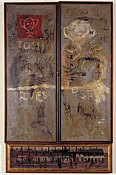 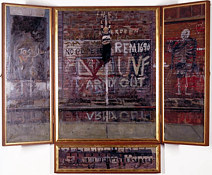 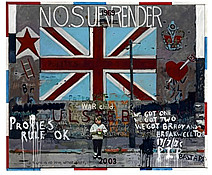 Ken Howard RA RWA: Northern Ireland in the 1970s Born in 1932, Ken Howard undertook National Service with the Royal Marines through 1954 - 55. During this time, he started making drawings of fellow servicemen and their surroundings. Posted to Plymouth in 1955 after basic training, he was offered his first one man show. Plymouth Art Gallery bought ten of his barrack room paintings for their schools collection. From 1973 Ken Howard began painting regularly for the British Army, working over the next decade for many regiments in locations world wide - Nepal, Belize, Hong Kong, Canada, Germany, Beirut, Cyprus, Oman, India, USA. In 1973 he was commissioned by the Imperial War Museum's Artistic Records Committee as an Official War artist to Northern Ireland (he received a second commission in 1978, largely to execute further pictures to replace ones lost in a fire). In Northern Ireland Howard worked in demanding and difficult circumstances, at one time he drew soldiers on surveillance on top of the Divis Flats, in Belfast, in an army sangar which was so cramped he had to make the drawings lying on his stomach. |
||
| War
Art and Artists: Official War Artists:
British |
||
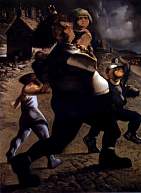 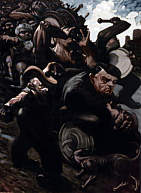
|
Peter Howson: Bosnia
in the 1990s Painter, born in London in 1958 moving to Scotland in 1962 where he trained at Glasgow School of Art. Peter belongs "to the same group as Ken Currie, Adrian Wisniewski, and Stephen Campbell in that he is interested in the social comment of his work rather than painterly qualities, colour and surface texture. He is a painter mostly of the male figure, often looking with a compassionate eye at the less fortunate members of society - the dossers, winos, derelicts and thugs. His period in the army is reflected in his paintings of mercenaries and he acted as official war artist during the Bosnian crisis." (From The Dictionary of Scottish Painters: 1600 to the Present 1998, Edinburgh). "Life is a confusion, war even more so. Howson's version of the truth is just as valid as a reporter's, or a photographer's, or a soldier's, maybe even more so because in some senses it is more profound. Truth be told, Howson did not see much in Bosnia, with his eyes. Nobody does. He did not get to Tuzla, or Sarajevo, or Mostar. He plodded around and found that war is hell, war is frightening, war is boring, war is hard, and ten times harder if you haven't got a lift home. But the truth is women do get raped in war, men do get castrated, children do turn into monsters. And Howson has seen it after all, in his imagination, and all too vividly. We all have. Wouldn't he be untruthful if he did not paint it? Someone has to." Robert Crampton, Facing Fear: Peter Howson in Bosnia, from the catalogue Peter Howson: Bosnia (1994 Imperial War Museum, London). Of his Bosnia work Howson said: "I'm not aiming to be controversial. But I wanted to cut out all the reportage. It's not my job to do that. My job is to do the things you don't see, that the army doesn't even get to see, not be an illustrator, not to tell stories,, but to produce strong images of things." Contact: Peter Howson is represented by Angela Flowers Galleries, London. top |
|
| War
Art and Artists: Official War Artists:
British |
||
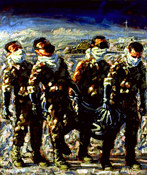
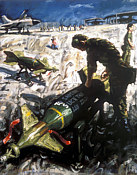 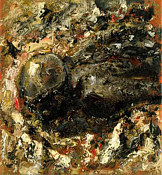 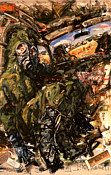 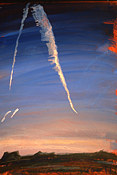 John Keane: Official Gulf War Artist 1992 Commissioned by the Artistic Records Committee of the Imperial War Museum, London to be the 'Official Recorder' in the Gulf War. Keane appears to have been selected on the strength of his figurative paintings which combine painterly brio with bold modelling and dramatic lighting. He had also a track record of pictorialising 'political events' (Orange Day parades in Northern Ireland) and had worked on troubled locations (Coal Miner's Strikes in UK; guerrilla activities in Nicaragua, Central America) which have been shown regularly at the Angela Flowers Gallery, London, UK. Keane was at the front for one month (4 February to 8 March 1991) taking photographs and gathering materials which he later incorporated into the surfaces of a suite of paintings. In Freedom of the Press US dollar bills and Saudi riyals are collaged around the edge as a contextual frame; in Ecstasy of Fumbling (portrait of the artist in a gas alert) the painted surface is augmented with nerve agent tablets, pages torn from an army manual on how to use an NBC suit and a colour reproduction of J.S. Sargent's painting 'Gassed'. 'For me certainly the most interesting bit was at the end, in Kuwait City. I wanted to let it sink in ; these things take time to think about, especially something like that which was completely unlike anything I had ever encountered before, and it did take a while to come to terms with it ... and find out how I felt about it.' Keane cited in Gulf (Imperial War Museum, 1992, p.17) ISBN 0 - 901627 - 83 - 6 www.johnkeaneart.com/ top |
||
| War
Art and Artists: Official War Artists:
British |
||
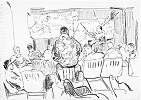 
|
Linda Kitson: The
Falklands, 1982 Kitson was commissioned by the Imperial War Museum and the Fleet Air Arm, left Southampton on May 12th 1982 and worked until 17th July producing over 400 drawings. From the day she boarded the requisitioned Queen Elizabeth II with 3000 British servicemen she drew continuously, recording the intensive training and preparation. She recorded the transfer at South Georgia to SS Canberra, the landings at San Carlos Bay. the deployment of the forces to Goose Green, to Fitzroy and Darwin, and finally to Port Stanley. Following the ceasefire in June she drew, often in bitter weather and diffciult conditions, the aftermath of the fighting. "Freezing temperatures and gales were a feature of airfields: a crater provided me with a windbreak of a kind ... I got so cold from watching from my crater that, when it was all over, I couldn't get up and had to be lifted out. Clearing up and cleaning was the way of life at Goose Green. Everyone there had suffered, every home was damaged, and now everyone helped everyone else. What I most appreciated were cups of coffee, and a warm-up by a fire. At Goose Green, I had to make a decision about what aspects of war I should record. My brief was to record the sights that might be recognised as common experiences. I decided that the horrifying sight of parts of human bodies, a helmet with a head still in it - pictorially sensational and relevant though they were - were not part of my brief; neither were the war graves, which were recorded on news films and in photographs. I still question that decision. Would it have been a stronger, cautionary record if I had used such shock tactics ?" Kitson (p.65) in The Falkands War: A Visual Diary (Mitchell and Beazley, 1982) ISBN 085533 457 6 top |
|
| War
Art and Artists: Official War Artists:
British |
||
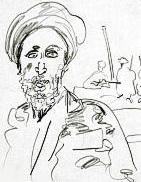
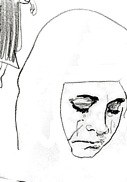

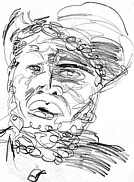 Mario Minichiello: in Afghanistan in the 1990s An illustrator, artist and academic, Mario worked between 1986-93 for BBC Newsnight as a reportage illustrator, making drawings for notable events such as the Spycatcher Trials, and pre-television coverage of the House of Commons, including the 'Guildford Four' appeals, and 'Beirut Hostage' releases. Born in Italy in 1961, he studied at Leicester Polytechnic and Saint Martin's School of Art, London. He has worked for many clients including the Guardian, The FT, Amnesty International, the Terence Higgins Trust, BBC Enterprises, Longmans, The Times, and ITN News. In 1999 his drawings were published in Mario Minichiello: Drawings and Prints 1996-99 ISBN 1-900856-38-7. Mario worked as an artist during the Afghanistan War and his book The Art Of Conflict? is a record of reportage drawings of the war; it is sold and exclusively distributed by MAG Landmines Advisory Group. The research for the book was supported by the Arts and Humanities Research Board (www.magclearsmines.org/index.htm). Of his work the cartoonist Steve Bell wrote: "Some drawings impress with their emotion and humanity, others impress with their technique; Mario's do both and, what is even better, because of the nature of their questioning, they make even this most cynical old hack want to go out and draw the world afresh." More of Mario's work can be seen by visting: www.eichgallery.org/artconflict/artfirst.html http://reportager.uwe.ac.uk/mmini.htm top back to featured artists |
||